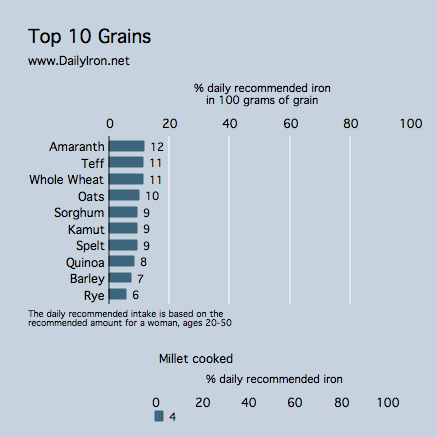Millet contains .62 milligrams of iron per 100 grams. Grams is a measure of weight. To put 100 grams in perspective; consider alternative measures for this food:
- 1 cup equals 174 grams.
In the category of grain; we included whole grains and flours in the Top 10 list. Foods may be fortified with iron but are not included in this Top 10 list.The food tested for the particular graph below can be described more specifically as:
Millet; cooked
Read more about iron in grains or visit our iron-rich foods list.

Millet: Is It Iron-Rich?
On its face, millet is high in iron but millet comes with an important footnote: it is high in a substance called phytic acid that inhibits iron absorption. You really will not benefit from the iron in the millet appreciably unless you reduce the phytic acid content of the millet. On this site and in detail in the Iron Rich Foods book we discuss reducing phytic acid in grains, legumes, nuts, and seeds. There are simple and straight-forward cooking techniques to do so. You can add iron enhancers to your meal to benefit even more. However, the problem with millet is that these methods are not really effective and you will end up not benefiting from the iron.
If you are shopping for grains that will help you with your iron levels, we do not recommend millet. If you love millet, you can use the tips and tricks to improve it, but if you are looking for an alternative grain to integrate into your cooking, perhaps amaranth or teff would do.
Search for your favorite foods in our searchable database and learn more about tips and tricks to add iron rich foods to your diet.